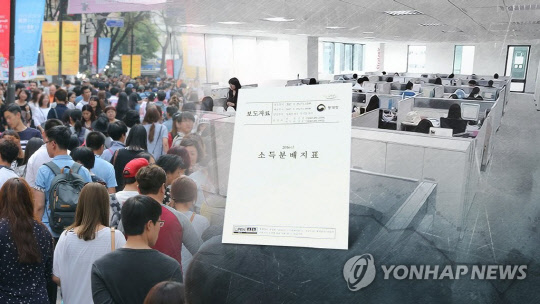Only ‘income polarization’ caused by supporting workers’ pocket
[ Kwon Dae-gyung kwon213@ ] | 2018-05-25 11:22:47
Reality of income led growth policy of Moon government
Since the inauguration of President Moon Jae-in, the household income gap between high-income and low-income households has been the highest ever. The richest 20 % of the income earned a significant increase, while the low-income group, whose income was below the 20 %, was in sharp contrast with a sharp decline in income. There is even an assessment that income-led growth has actually failed in and out of the government.
According to the National Statistical Office (NSO)`s first quarter of 2018 on May 24, the average income per household in the first quarter was 4.673 million won. This is an increase of 3.7% from the previous year
The total income level has increased, but the situation is serious in terms of income quintiles. Especially, the income gap between the highest income earners and the lowest income earners was the largest since the 2003 statistics. Household income in the fifth quintile, which is the top 20 % of household income, grew by 9.3 % in the first quarter, while the income of the lowest quintile fell to -8.0 %. The average income of the fifth quintile households was KRW 10,151,700 (9.3%), exceeding KRW 10 million for the first time, while the first quintile fell to KRW 128,670 (-8.0%). The number of people in the first quarter increased by KRW 861,000 won from KRW 92.9 million in the same period of last year in the 5th decile, while the income of the first decile decreased from KRW 139,800 to KRW 111,700.
The problem is that the polarization has become more recent. In the case of Park Geun-hye government, the first-quarter income rose 7.6 % to KRW 1452,000 in 2015, while the fifth-decile income rose 2.4 % to KRW 8.90 million. The income increase is naturally higher in the 5th quintile, but the growth rate shows that the income gap is somewhat eased by the low income group.
Households with more than two employees who were able to dispose of equally-priced households were 5.95 times more than the previous year (5.35 times) in the first quarter of the year, which is the worst since 2003 statistics. Disposable income refers to the portion of income that can be freely consumed, except for non-consumption expenditures such as taxes and social security contributions.
Kim Jung-ran, director of the Welfare Statistics Bureau at the National Statistical Office, said, "As the retirement households are included in the first quintile due to the aging trend, the first-quarter income seems to have fallen sharply.
Meanwhile, experts expressed concern that the polarization caused by widening income disparity is becoming a critical issue for the Korean economy. Yang Jun-mo, a professor of business administration at Yonsei University, stated "The sharp increase in the minimum wage has led to a decline in the number of jobs, and the damage has been witnessed by low-income earners." The government reviewed the policy so far, we need to increase our jobs. "It is analyzed that the paradigm of the economic policy should be largely restructured so that the fundamental solution of low birthrate and aging and income polarization can be found as the minimum wage policy eventually became a `poison` for the low-income class.”
By Sejong City=Kwon Dae-gyung • Hwang Byung-seo kwon213@dt.co.kr



